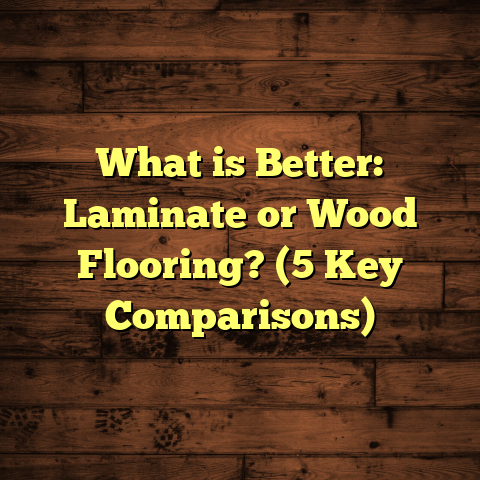What is Engineered Wood vs Laminate Flooring? (5 Key Differences!)
I remember the first time I stood in a client’s living room with a stack of flooring samples in my hands, sweating bullets because I knew how important this decision was for them. It was a crucial project early in my career, and they wanted floors that looked stunning but could handle the chaos of everyday life with kids and pets. That’s when I realized how much confusion there is around engineered wood and laminate flooring. Since then, I’ve installed dozens of floors using both materials, and I’ve learned a ton about what makes each unique—and how to help clients pick the right one for their homes.
If you’re planning to redo your floors or building a new space, the choice between engineered wood and laminate often comes up. They both promise wood-like looks and durability, but they work very differently once you get under the surface. I’ll share what I’ve learned about these two flooring types through real-life projects, plus some data-backed info and practical advice you can use.
What’s Under the Surface? Understanding Engineered Wood and Laminate
Before getting into the nitty-gritty, here’s a quick refresher on what these floors actually are—but without boring definitions.
Engineered wood flooring is built like a wood sandwich. Imagine thin layers of plywood glued together with a real hardwood veneer on top. That top layer is actual wood—oak, maple, walnut—you name it. The layers below provide stability so the floor resists warping better than solid hardwood, especially in places with humidity swings.
Laminate flooring is more like a high-tech wood costume. It’s made mostly from compressed fiberboard topped with a high-resolution photo of wood grain sealed under a tough plastic wear layer. It looks like wood but isn’t made from actual wood on the surface.
I’ve seen people confused about whether laminate is “fake” wood and whether engineered wood is “real” enough to justify the cost. The truth is both have pros and cons depending on what you need.
1. Looks and Feel: Real Wood or Just Lookalike?
When I’m helping homeowners choose floors, appearance is usually the first thing they ask about. “Will it look like real wood?” they wonder.
Engineered wood has a real hardwood surface, so it looks and feels authentic underfoot. You get natural grain patterns, color variations, and textures that develop character over time. Because it’s real wood on top, you can sand it once or twice during its lifetime to refresh the finish or fix scratches.
Laminate flooring uses photographic images of wood printed on its surface. The latest laminates have incredibly realistic textures that mimic wood grain, knots, and even distressed looks. But if you run your hand over laminate, it feels smoother and more synthetic than engineered wood.
In one project for a client who loved rustic farmhouse style, we installed an engineered hickory floor in the kitchen and high-end laminate in the hallway to test which one they liked better over six months. The engineered wood won hands down for its warmth and natural feel, but the laminate was praised for its scratch resistance and easy cleaning.
Can You Tell Laminate From Engineered Wood?
If you’re just looking at photos online or in catalogs, it’s almost impossible to tell them apart nowadays. But in person? Most people notice the subtle differences immediately—especially when they walk barefoot or touch the floor.
Even some contractors get fooled until they inspect the plank edges or lift a board to see the core.
2. Durability: Which Floor Can Handle Your Life?
Durability is where these two really start to show their differences. As someone who’s repaired floors after kids dropped toys or pets scratched surfaces, trust me—this matters.
Engineered wood does well resisting humidity changes because of its layered plywood construction underneath the hardwood veneer. However, since the top is real wood, it scratches and dents more easily than laminate.
Laminate’s wear layer is made from melamine resin—a very tough plastic that resists scratches, scuffs, stains, and fading from sunlight better than most finishes on engineered wood.
A manufacturer’s test I reviewed showed that laminate flooring can withstand abrasion cycles (simulating foot traffic) three times higher than engineered wood finishes before showing wear.
That said, engineered wood can be refinished once or twice depending on how thick its top layer is—laminate can’t be sanded or refinished because the printed surface would be ruined.
Over time, laminate tends to maintain its original look longer without needing repairs or refinishing. But if you want genuine wood that ages naturally with character marks, engineered wood is your choice.
3. Installation: DIY Friendly or Expert Job?
One thing I tell clients right away: installation matters a lot for how your floors turn out—both visually and in terms of lifespan.
Engineered wood offers multiple installation methods:
- Nail-down: Traditional method used over wooden subfloors.
- Glue-down: Often used over concrete slabs.
- Floating: Planks click together but aren’t glued or nailed down.
Each method requires different prep work and tools. If you try a nail-down without experience, you risk damaging the boards or making the floor uneven.
Laminate is almost exclusively a floating floor system with click-lock planks that snap together quickly without glue or nails. This makes it very popular for DIYers or fast renovations where minimal downtime is important.
I’ve helped friends install laminate floors in basements and spare rooms because it was easy to learn and didn’t require heavy equipment like nail guns or adhesives.
4. Maintaining Your Floors Without Losing Your Mind
Here’s something I hear all the time: “I want floors that look great but don’t need constant care.”
Engineered wood needs gentle treatment—regular sweeping or vacuuming plus damp mopping with cleaners made for hardwood floors. Water spills must be wiped immediately because excess moisture can seep into seams and cause swelling or warping.
Laminate is easier to clean since its sealed plastic surface won’t absorb water or stain easily. You can mop without worrying about damage as long as you avoid soaking it.
In a family home where pets track mud daily, laminate proved a lifesaver. Owners told me they could just wipe mud prints off without scrubbing or using special products.
5. Cost: What Will Your Wallet Say?
Budget plays a huge role in choosing floors. In my experience:
- Engineered wood ranges from $5 to $15 per square foot (material only), depending on hardwood type and finish.
- Laminate flooring usually costs between $1.50 and $5 per square foot.
Installation costs vary too—engineered wood installation typically runs higher because of prep work and skilled labor needed for nailing or gluing.
For quick budgeting estimates in my projects, I use FloorTally. It lets me input local material prices, labor rates, waste factors, and project size to get accurate total cost projections within minutes. This keeps clients informed early so we can adjust materials or scope before ordering anything.
Digging Deeper Into Appearance and Design Choices
I want to give you some personal stories about style because choosing floors isn’t just about durability—it’s your home’s personality too.
Texture Matters More Than You Think
I once worked on a coastal home where the owners loved whitewashed oak floors with a textured finish that felt rough like driftwood. Engineered wood was perfect because we could find planks with natural hand-scraped texture that gave an organic look.
Laminate can mimic textures too but often feels more uniform because it’s machine-made. If you want your floor to invite people to walk barefoot and feel character underfoot, engineered wood has an edge here.
Color Trends
Over the past decade, I’ve noticed shifts in popular flooring colors:
- Early 2010s favored dark espresso tones.
- In recent years, lighter colors like blonde oak or gray tones dominate modern interiors.
Both engineered wood and laminate come in these colors now—but engineered wood colors are achieved naturally through stains and finishes whereas laminate colors rely on photographic printing.
One client wanted a Scandinavian vibe with pale oak floors but had budget constraints; we chose high-end laminate with grayish tones that looked almost identical to real oak but came in at half the price.
Customization Options
With engineered wood, you can choose species (maple vs walnut), plank width (narrow vs wide), finish type (matte vs glossy), and even bevel styles on edges for different looks.
Laminate offers less customization but has many pre-designed styles including distressed, hand-scraped looks, exotic woods, and even stone-look laminates if you want something different.
Durability Deep Dive: What Life Throws at Your Floor
Let me share some real flooring battle stories from my projects.
Scratch Tests: Kids vs Floors
One family I worked with had two toddlers who loved playing with toy cars indoors—sharp wheels met hardwood surfaces daily. Their engineered oak floors showed scratches after six months despite careful supervision.
In comparison, their neighbor installed laminate flooring in similar conditions; after two years of relentless toy abuse, the floor looked almost brand new.
This matches research data showing laminate’s hard wear layer offers superior scratch resistance compared to engineered hardwood finishes—which are softer due to natural wood fibers.
Moisture Resistance: Basement Challenges
Basements are tricky spots for flooring because moisture levels fluctuate. I guided a client choosing between engineered wood (not generally recommended for basements) versus laminate with waterproof cores designed specifically for damp environments.
We went with waterproof laminate which held up perfectly against occasional basement humidity spikes—no warping or swelling even after heavy rains outside.
Refinishing Real Wood vs Replacing Laminate
When engineered wood gets scratched deeply or worn out after years of use (usually 15-20+ years), it can be sanded down and refinished 1-2 times depending on veneer thickness (often 2-6mm).
Laminate doesn’t offer this option—damaged planks need replacing entirely which can be tricky if discontinued styles are involved.
Installation Insights: How to Avoid Common Pitfalls
If you’re thinking about DIY installation or hiring pros, here are tips from my experience:
Subfloor Prep Is Key
Both materials require level subfloors but engineered wood demands extra care for moisture barriers if installed over concrete slabs to prevent warping.
Laminate installation requires an underlayment—usually foam or cork—to reduce noise and provide cushioning. Skipping this step reduces lifespan drastically by causing planks to loosen or squeak over time.
Acclimation Period
Engineered wood planks need to acclimate in your home for several days before installation so they adjust to humidity levels—skipping this leads to gaps or buckling later.
Laminate acclimation is less critical but still recommended by some manufacturers especially in very humid or dry climates.
Tools You’ll Need
For engineered hardwood:
- Nail gun (for nail-down)
- Flooring adhesive (for glue-down)
- Moisture meter (to check subfloor)
For laminate:
- Saw for cutting planks
- Spacers for expansion gap
- Rubber mallet to lock planks together
Maintenance Made Simple: Tips That Save You Time
I often recommend these routines:
Engineered Wood Care:
- Sweep/vacuum regularly using soft-bristle tools.
- Avoid wet mopping; use barely damp microfiber mop.
- Use pH-neutral cleaners designed for hardwood.
- Place felt pads under furniture legs.
- Clean spills immediately.
- Avoid high heels or heavy objects that dent easily.
- Schedule refinishing every 10-15 years if needed.
Laminate Care:
- Sweep/vacuum regularly.
- Mop lightly with water or mild soap solution.
- Avoid standing water.
- Use mats at entrances to reduce dirt.
- Avoid abrasive cleaners or steam mops.
- Replace damaged planks if necessary; keep spare boards from original purchase.
Cost Breakdown: How Much Should You Budget?
To give you clearer numbers based on my projects:
| Flooring Type | Material Cost per sq ft | Installation Cost per sq ft | Total Cost Estimate (per 1,000 sq ft) |
|---|---|---|---|
| Engineered Wood | $5 – $15 | $3 – $8 | $8,000 – $23,000 |
| Laminate | $1.50 – $5 | $1 – $3 | $2,500 – $8,000 |
These ranges depend heavily on region and species chosen. For example:
- Exotic woods like Brazilian cherry push engineered prices toward the high end.
- Basic oak laminates are usually at the low-to-mid range of laminate prices.
Using FloorTally has been a game changer for me when quoting projects because it pulls local labor rates automatically and applies waste factors (usually 5%-10%) so you don’t underestimate material needs.
Real Client Case Study: A Tale of Two Floors
A family of five wanted durable floors for their open concept kitchen/dining/living area totaling 900 sq ft. They asked me whether to invest in engineered oak or save money with laminate replica oak planks.
We started by identifying their priorities:
- Kids aged 6 & 8 meant lots of spills/toys
- Frequent entertaining guests
- Moderate budget but willing to spend if value justified
After crunching numbers using FloorTally:
- Engineered oak option totaled ~$12k (materials + pro install)
- Laminate option totaled ~$6k (materials + DIY install)
They decided on laminate due to budget constraints but selected a premium textured product with lifetime warranty against wear/scratch/stain.
Two years later they reported:
- Floors look fantastic
- Easy cleanup
- No noticeable wear marks despite heavy use
This case showed how understanding real needs combined with clear cost projections helps avoid buyer’s remorse.
Common Myths About These Floors—Busted!
Let me clear up some misconceptions I hear often:
Myth #1: Laminate Flooring Is Cheap-Looking
Truth: High-quality laminates use advanced printing techniques that replicate natural woods closely—including textures—and come with warranties rivaling expensive hardwoods.
Myth #2: Engineered Wood Won’t Last Like Solid Hardwood
Truth: Engineered wood with thick veneers can last decades with care—even longer than some solid planks prone to cupping in humid environments.
Myth #3: Laminate Flooring Is Slippery
Truth: Many laminates come with textured finishes providing grip; slip risk varies more by finish than material type alone.
Myth #4: You Can’t Install Engineered Wood Over Radiant Heat
Truth: Many engineered products are designed specifically for radiant heat compatibility; always check manufacturer specs though!
What About Environmental Impact?
If sustainability matters to you:
- Engineered wood uses less solid hardwood per plank than traditional hardwood floors.
- Many manufacturers source plywood layers from managed forests.
- Laminate uses synthetic materials that might not be biodegradable but often have recycled content.
Personally, I ask clients if they want FSC-certified woods or low-VOC adhesives for indoor air quality when choosing engineered options.
So… Which One Should You Pick?
Here’s a quick checklist based on what I’ve learned working with hundreds of homeowners:
| Factor | Choose Engineered Wood If… | Choose Laminate If… |
|---|---|---|
| Authenticity | You want real hardwood feel & look | You want budget-friendly realistic looks |
| Durability | Moderate traffic & careful maintenance | Heavy traffic & kids/pets presence |
| Installation | Will hire pros or skilled DIY | Want easy DIY installation |
| Maintenance | Don’t mind regular gentle care | Prefer easy cleaning & stain resistance |
| Budget | Can spend $8-$20 per sq ft all-in | Need cost-effective solution <$7 per sq ft |
Wrapping Up My Flooring Journey With You
Choosing between engineered wood vs laminate flooring isn’t just about picking a material—it’s about matching your lifestyle, aesthetic taste, budget, and how much effort you want to put into caring for your floors over time.
Having worked both sides professionally—and helped friends DIY—I can say there’s no wrong choice if you pick according to your priorities honestly.
If you want help balancing style vs cost quickly during your project planning phase, tools like FloorTally have saved me hours by giving accurate local pricing breakdowns instantly rather than guessing or chasing quotes endlessly.
I hope sharing my experiences plus data insights helps you feel confident when making your next flooring decision. If you have questions about installation techniques, product brands I trust, or how to maintain either floor type effectively—I’m here to chat!
What kind of flooring are you leaning toward? Or have you tried either one before? Drop me a line—I love swapping stories from the flooring trenches!





